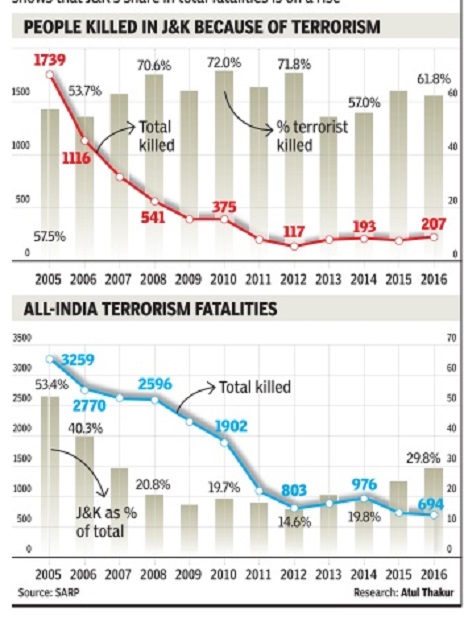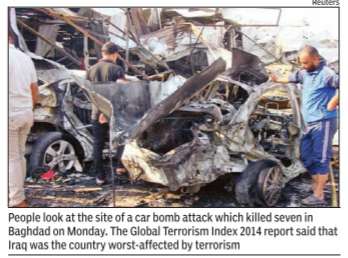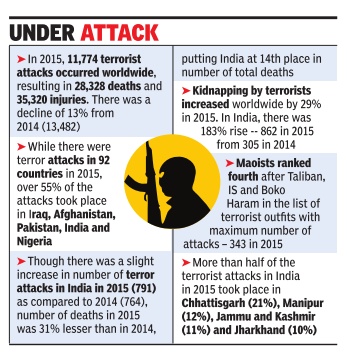Terrorism in India
This is a collection of articles archived for the excellence of their content. |
Contents |
Base Movement
2015-16: attacks courts
Terror Group `Base Movement' Felt Judiciary Was Giving Muslims A Raw Deal, Says NIA Chargesheet
A chargesheet filed by National Investigation Agency (NIA) last week against Base Movement, a terror outfit that owed allegiance to al-Qaeda, says that the outfit carried out five blasts in court premises in south India last year to avenge the killing of Hizbul Mujahideen leader Burhan Wani by Indian security forces, encounter killing of Ishrat Jahan in Gujarat, hanging of Yakub Memon and killing of eight alleged SIMI terrorists in Madhya Pradesh in 2016.
NIA says in its chargesheet that the September 12, 2016 blast at Nellore court was carried out by the outfit to avenge the “mental agony“ suf fered by Kashmiri Muslims for about two months when Section 144 (prohibitory orders by the government) was imposed in parts of the valley following the killing of Burhan Wani.
It says that the outfit carried out the August 1, 2016 Mysuru court blast to avenge the hanging of 1993 Mumbai serial blast accused Yakub Memon and killing of eight alleged SIMI terrorists by Madhya Pradesh police.
Similarly , Base Movement carried out the June 15 blast at Kollam court to avenge the encounter killing of Ishrat Jahan in Gujarat.They also wanted to avenge lynching of Mohammad Akhlaq in Noida.
According to the NIA chargesheet, exclusively accessed by TOI, the members of the outfit also felt that Muslims lodged in jail were being ill-treated and courts were handing them a raw deal.
The chargesheet has been filed against Nainar Abbas Ali, Dawood Sulaiman and Samsun Karim Raja on May 24. Abbas and Sulaiman formed the outfit on January 26, 2015 at Madurai. Two members of the outfit, S Shamsudheen and Mohammad Ayub, are yet to be chargesheeted.
NIA chargesheet says that after forming the outfit Ali asked Dawood to look for the address of government offices in Tamil Nadu, Kerala, Karnataka, Andhra Pradesh, Delhi, Mumbai and media houses.
Dawood prepared threat letters and same were sent to office of Tamil newspaper Dinamalar, various jails in Tamil Nadu namely Puhal, Kovai, Vellore, Salem, Nellai, Cuddalore, Madurai and Trichy apart from French consulate at Bengaluru.
They had printed a threat letter with Base Movement template on it threatening the then French President Francois Hollande.
The Base Movement carried out five blasts in court complexes at Mysuru, Nellore, Mallapuram, Kollam and Chitoor between April and November last year and had sent lettersvideos, SMS and WhatsApp messages to police and administration each time claiming responsibility for the blasts.
They also sent threat letters to the editor of Tamil newspaper Dinamalar in January 2015 threatening them with a Charlie Hebdo type attack.
In the threatening videos recovered from them, NIA has found clippings of Prime Minister Narendra Modi, senior BJP leaders, L K Advani, Rajnath Singh, Gen (retd) V K Singh, VHP leader Praveen Togadia, and pictures of embassies of US, Russia, France, Israel and Myanmar.
“The aim of the outfit was to send message to government and warn it against the atrocities being perpetrated over Muslims by different organs of the government. The outfit believed that the Muslims accused in various cases such as Imam Ali escape case, the case related to attack on BJP leader L K Advani etc who were lodged in different jails in Tamil Nadu have been handed a raw deal by the courts, prisons etc,“ says NIA the chargesheet.
Cities with a high risk of terror
2014: Imphal, Srinagar
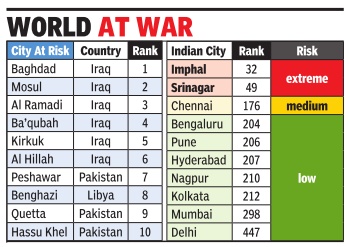
May 22 2015
2 Indian cities at high risk of terror strike
Kounteya Sinha
Two Indian cities -Imphal (ranked 32) and Srinagar (ranked 49) have been named to be at “extreme risk“ of a terrorist attack, mainly aiming to cause mass casualty and destroy public transport networks. According to an analysis of the terror risk to 1,300 commercial hubs and urban centres around the world, populations and businesses in 113 Indian cities have been identified to be at some risk -high, medium or low -of facing terrorist attacks.
The next major Indian city that faces a terrorist threat is Chennai with its risk quotient marked as medium. Bangalore is fourth among Indian cities, even though it is placed at 204th globally , followed by Pune and Hyderabad at 206th and 207th, respectively.
Around 64 cities around the world are at “extreme“ risk, with most in the Middle East and Asia, and three in Europe. While London ranked as low as at 400 due to the lack of a terror incident since the 77 bombings, Paris soared into the top 100 following the Charlie Hebdo shooting, according to Verisk Maplecroft's new Global Alerts Dashboard.
Arvind Ramakrishnan, head of Maplecroft India said, “When it comes to Imphal and Srinagar, terrorist attacks aren't on commercial targets as much as against the security forces.Public transport networks in India are also prime targets“.
Court verdicts
Terror propagandists lethal too: HC
Terror propagandists lethal too, says HC, May 21, 2017: The Times of India
Propagandists for terror are as lethal as those who use bullets, the Delhi high court has observed, rejecting bail plea of two men.
Justice Ashutosh Kumar recently dismissed the bail applications of Asif Bashiruddin Shaikh and Akbar Ismail Choudhary , accused of being part of the media cell of terror group Indian Mujahedeen.
HC said it was not inclined to grant the relief at a stage when the trial court is yet to finish examining all the 610 witnesses.
The lawyer for the two accused had claimed that the role attributed to them by the prosecu tion is that they were part of IM's media cell which sent out threat emails after the blasts which claimed 27 lives and injured 135.
Urging HC to take note, the accused said they had moved the high court for bail for the first time now since being arrested in 2008. They arguing that it could take a substantial amount of time for the trial to finish since till date only 221 out of the 610 witnesses have been examined.
When the accused tried to play down their alleged role saying were at worst only part of the media cell, HC said, “Dissemination of propaganda in such cases was more lethal than the use of bullets or detonating of an IED.“
Fatalities Related to Terror
2005-16, i) J&K; ii) All India
2016 TERROR-RELATED FATALITIES IN J&K REACH 5-YEAR HIGH Oct 12 2016 : The Times of India
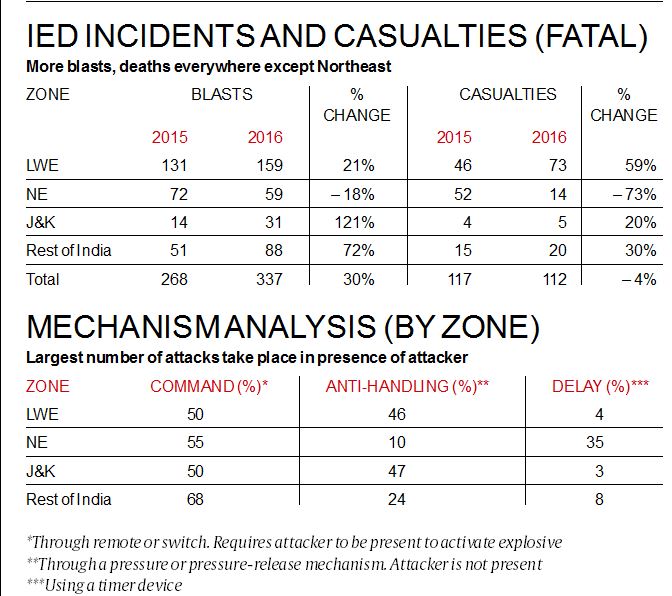
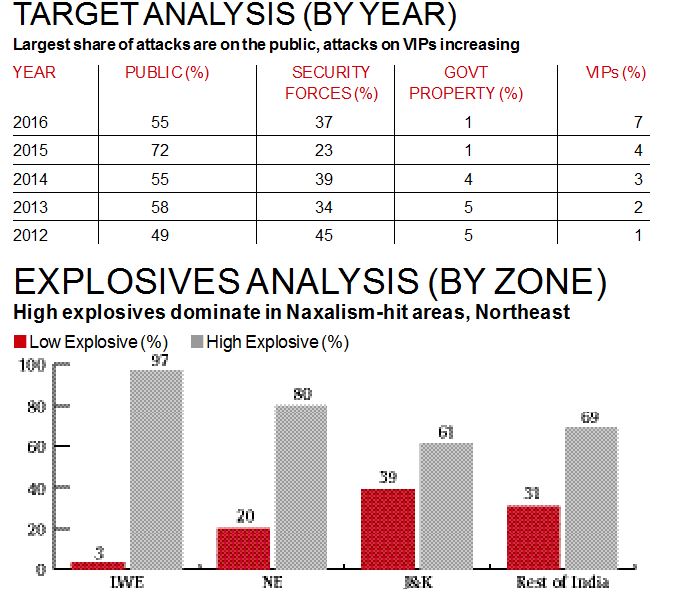
The total fatalities (civilians, security forces and terrorists) linked to terror incidents in Jammu & Kashmir is 207 for the period between January and Oct 2016--highest since 2010. The comparison of terror fatalities in Jammu & Kashmir with the rest of the country also shows that J&K's share in total fatalities is on a rise
See graphic
Terror suspects later acquitted/ discharged
Some representative cases
The story of Mohd Hussain Fazli and Mohd Rafiq Shah, the terror accused acquitted in the 2005 Delhi blasts after losing precious years in jail, resonates with several families across India. The aquittals of several terror suspects after years-long incarceration have time and again raised questions about the investigation carried out by various agencies.
In Maharashtra alone, for example, over 30 terror suspects have been either acquitted or discharged since 2004.“It's difficult to live with the same dignity in society once police label you a terror suspect,“ said Abdul Wahid Shaikh, a 711 suspect acquitted in 2015. Sheikh's son was two years and daughter six months old when he was arrested. “One cannot understand the trauma I went through. We were humiliated, beaten up and tortured during interrogation,“ he said.
“The state government has no system of rehabilitation. It's easy for people to say things get normal after acquittal. That's not true. I got my teaching job back but ev eryone is not that lucky. Most of those acquitted face financial problems when they want to start a new life,“ said Shaikh, who was accused of harbouring the Pakistanis who bombed the trains.
Hanif Sheikh, who came out of jail on February 2 after 13 years following his acquittal in the Ahmedabad tiffin blasts case, said he had no clue how to start life afresh. “In 2007, my mother died of shock with a prayer on her lips to see me out of jail. My wife, bedridden with depression since my arrest, succumbed a year later. My elder sister, who struggled to rear my children and fight my legal battle, died in 2009.My eldest daughter, a bright student, was forced to drop out due to non-payment of her school fees. There is no justice in pronouncing me innocent as the system has wronged me and my family ,“ he said.Sheikh used to run a garments business but it is all lost now.
Adam Ajmeri (54), who was facing the gallows until the SC acquitted him in the Akshardham attack case in 2014, said his friends and relatives turned their backs on him despite the clean chit. He could start life afresh only after two research scholars from National Law University collected Rs 7 lakh for him through crowd-funding. “No one would give me a job. My wife and six children were forced to survive on alms. I had turned suicidal when Allah sent the two good men who gave me Rs 7 lakh to start my dairy business,“ he said.
Right-wing groups accused of terrorism
2006-2018
April 17, 2018: The Times of India
Malegaon blast 2006
37 fatalities and 125 injuries in two consecutive blasts on September 9, 2006. NIA linked the 2006 case with Hindu fringe group Abhinav Bharat and filed a chargesheet in May 2013 naming Manohar Narwaria, Rajendra Chaudhary, Dhan Singh and Lokesh Sharma (named today as well in Malegaon 2008 case). In April 2016, court discharged the 8 Muslim men in case.
STATUS: Case is at trial stage
Malegaon Blast 2008
On September 29, 2008, a blast in Malegaon left September 4 dead, 79 injured. Probing the case initially, Maha ATS claimed former ABVP activist Sadhvi Pragya Thakur, a right wing group Abhinav Bharat was behind the blast in conspiracy with Lt Colonel Prasad Purohit. NIA took over the case in April 2011 and filed a chargesheet in 2016 dropping charges against Sadhvi Pragya Singh and five others Shiv Narayan Kalsangra, Shyam Bhavarlal Sahu, Praveen Takkalki, Lokesh Sharma and Dhan Singh Choudhury.
STATUS: NIA court in December 2017 said Sadhvi Pragya and Purohit will stand trial under terror charges
2007 Mecca Masjid blast case
May 18, 2007, pipe bomb went off in 17th century Mecca Masjid, Hyderabad in which 9 killed, 58 injured. NIA chargesheeted ten persons including Aseemanand and Sunil Joshi. Joshi was shot dead by unidentified persons in Dewas, Madhya Pradesh, on December 29, 2007, while key witness Lt Col Shrikant Purohit was declared hostile in February 2018
STATUS: Court acquitted all five arrested accused of all charges on April 16, 2018:
Ajmer Dargah blast 2007
On October 11, 2007, a blast rocked the Dargah Khwaja Moinuddin Chishti in Rajasthan killing three and injuring 17. NIA filed chargesheet against Aseemanand, along with Sandeep Dange, Bhawesh Patel, Mehul, Suresh Bhai, Ramchandra Kalsangra, Sunil Joshi and Bharat Bhai
STATUS: Special NIA court on March 8, 2017 acquitted Aseemanand but sentenced to life Devendra Gupta and Bhavesh Patel. NIA didn’t challenge the acquittal
Samjhauta blast 2007
On February 18, 2017, 68 persons lost their lives when bombs went off in Samjhauta Express, a peace train between India and Pakistan near Panipat. NIA had claimed earlier that Aseemanand had confessed that he was involved in the bombing of the train, a statement he later claimed to have made under duress. US declared Arif Qasmani, a Pakistani national and alleged ‘LeT financier’, to be the chief coordinator of Samjhauta bombings, and the UN labelled him an international terrorist.
STATUS: Case is on at trial stage and NIA court is waiting to record the statement of 13 Pakistani nationals
2018: Haryana does not clear prosecution of right-wingers
Ajay Sura, August 6, 2018: The Times of India
The trial of a case, where a Muslim trader from Uttar Pradesh was slapped by right-wing activists outside Hisar mosque last year in July for not chanting “Bharat Mata Ki Jai,” has not started as yet due to lack of sanction from the Haryana government for prosecution.
As the charges include Section 295-A (hurting religious feelings), permission under 196 CrPC is required from the Haryana home department, headed by chief minister Manohar Lal Khattar, for prosecution.
A case was registered against some right-wing activists on July 11, 2017 and the Hisar prosecution agency had written to the home department for sanction on August 19.
The matter came up for hearing before the trial court in Hisar on July 17, 2018, where the judicial magistrate (first class) expressed surprise over delay in sanction for prosecution and directed the prosecution agency to send a reminder to the Khattar government. The next hearing has now been fixed for September 11.
“The delay is unprecedented because normally such sanction is received within 3-4 months. The trial of the case has not commenced for want of sanction,” Vikram Mittal, counsel for the complainant told.
2018: Maharashtra group plotting to blast communal amity
The Maharashtra ATS said that it had recovered a fresh cache of arms and ammunition from the hideouts of the three people arrested for plotting bomb blasts to disturb communal amity.
ATS officials said that based on information provided by gau rakshaks Vaibhav Raut, Sharad Kalaskar and Sudhanva Ghondalekar, they recovered 11 pistols with magazines, 10 pistol barrels, an airgun, six partially made pistol bodies, three partially made magazines, 16 relay switches and one trigger mechanism battery, among other items. On Friday, ATS had said it had recovered 20 bombs and other ammunition.
While ATS had said the bombs and bomb-making material had been seized from Raut’s Nalasopara bungalow, officials refused to divulge details of the location where the firearms seized on Saturday had been kept.
CM Devendra Fadnavis told TOI the ATS operation was conducted after gathering a lot of intelligence. “The material seized is dangerous and could have been used for antisocial and terror acts,” he said. “The inquiry is still being conducted, and the motive and targets will be extracted through this inquiry,” he said. Sources said the arrested had apparently stored the cache but may not have manufactured the material. The ATS suspects there may be six to seven more sleeper cells in the state .
World ranking
2013: India 6th worst terror-hit country
Kounteya Sinha
Attacks Increased By 70% From 2012 To 2013, Toll Up From 238 To 404: India was the sixth worst-affected country by terrorism in 2013 -the other five being war zones at present. This came out in the Global Terrorism Index 2014 report which also said that the number of deaths from terrorism increased by 61% between 2012 and 2013.
There were nearly 10,000 terrorist attacks in 2013, a 44% increase from the previous year. But India witnessed a much higher increase of terrorist attacks during the same period -while terrorism increased by 70% in India from 2012 to 2013, the number of deaths increased from 238 to 404.
The report said that in India there remains significant terrorist activity including on the border between India and Pakistan. As many as 43 different terrorist groups were found to be operational in India and were categorized into three groups: Islamists, separatists and communists. They were found to have planned and carried out attacks.
Over 80% of the deaths from terrorist incidents in 2013 were recorded in just five countries: Iraq, Afghanistan, Pakistan, Nigeria and Syria. On a scale of one (low est impact of terrorism) to 10 (highest risk of terrorism) -Iraq which has emerged as the world's worst-affected country with terrorism is the only entry with a score of 10. India had a score of 7.86.
The largest year-on-year increase in deaths from terrorism was recorded between 2012 and 2013 increasing from 11,133 to 17,958. As many as 87 countries experienced a terrorist incident in 2013, slightly up from 81 in 2012. The number of countries experiencing over 50 deaths in one year hit an alltime high in 2013 at 24, five greater than the previous high of 19 countries in 2008.
About India, the Index said, “The number of attacks increased with 55 more attacks in 2013 than 2012. But the majority of terrorist attacks in India have low casualties. In 2013 around 70% of attacks were non-lethal.
“Communist terrorist groups are by far the most frequent perpetrators and the main cause of deaths in India. Three Maoist communist groups claimed responsibility for 192 deaths in 2013, which was nearly half of all deaths from terrorism in India.
“Police are overwhelmingly the biggest targets of Maoists, accounting for half of all deaths and injuries. This is mainly through armed assaults, which killed 85, and bombings and explosions, which killed 43,“ the report said.
The dispute with Pakistan over Jammu & Kashmir is the source of Islamic terrorism in India, according to the report. In 2013 three Islamist groups were responsible for around 15% of deaths in India. This includes Hizbul Mujahideen which was the only group in India to use suicide tactics in 2013.
“Islamist groups in India commonly use armed assaults targeting the police or bombings targeting private citizens. The majority of attacks occur in Hyderabad and Jammu & Kashmir,“ the report said.
Globally, four terrorist groups -al-Qaida, Boko Haram, ISIS and the Taliban were responsible for 66% of all deaths from terrorist attacks in 2013 in which the perpetrator was known.
2015: CPI (Maoist) world’s fourth deadliest terror outfit
The world witnessed 11,774 terror attacks in 2015, in which 28,328 people were killed and 35,320 injured. India was the fourth worst-affected country after Iraq, Afghanistan and Pakistan, with 43% of 791 attacks in the country carried out by Naxalites. A total of 289 Indians died in terror strikes.
Data collected by the National Consortium for the Study of Terrorism and Responses to Terrorism cont racted with the US state department revealed that Taliban, Islamic State and Boko Haram were the three deadliest terror groups globally. They were followed by CPI (Maoist), a banned outfit. The CPI(Maoist) was responsible for 343 terror attacks in 2015, killing 176 people. Taliban were involved in 1,093 strikes in which 4,512 people lost their lives, IS launched 931 attacks which claimed the lives of 6,050 people and Boko Haram was involved in 491 attacks killing 5,450 people. Kurdistan Workers' Party (PKK), which rounded off the top five in the list, was involved in 238 strikes, killing 287.
Over half the terror at tacks in India took place in four states -Chhattisgarh (21%), Manipur (12%), J&K (11%) and Jharkhand (10%).Chhattisgarh, which has been hit hard by Left-wing extremism, reported a doubling of terror attacks in 2015 -from 76 in 2014 to 167. The report said there was great diversity in the perpetratorsterrorist groups involved in attacks in the country , with 45 outfits ac tive across the country . The Naxals alone accounted for 43% of terrorist attacks in India last year. The report said the number of people kid nappedtaken hostage by terrorists and insurgent groups in India almost tripled in 2015, increasing to 862 from 305 in 2014. Of this, Naxals alone kid nappedtook hostage 707 persons last year compared with 163 in 2014. In 2014, there were no attacks in which 50 or more people were kidnapped or taken hostage while in 2015, there were seven such attacks, all of them attributed to Maoists.
Home ministry data also said that between 2010 and 2015, 2,162 civilians and 802 security personnel were killed by Naxals. Most of the dead were `tribals', often branded as police informers.
The report said that while India ranked high among countries witnessing terror attacks, the lethality of these attacks were relatively low.The number of perpetrators terrorists killed in attacks in India doubled in 2015, accounting for 20% of all deaths compared with 7% in 2014. In all, 6,924 terrorists (24%) were killed in the attacks perpetrated by them worldwide. The use of bombsexplosions as tactic for attacks was less prevalent in India than worldwide.
2017: India 3rd worst hit, after Iraq, Afghanistan
For second year in a row, India is the third largest victim of terror attacks across the world after Iraq and Afghanistan while CPI-Maoists, which carried out 53% of the total attacks in India, is the fourth deadliest terror group after Islamic State, Taliban and Al-Shabaab, according to the data released by US department of state.
Till 2015, Pakistan was the third most affected country in the world.
The national consortium for the study of terrorism and responses to terrorism, contracted by the US department of state, has claimed that Jammu and Kashmir witnessed a 24% increase in terror attacks in 2017 and an 89% increase in the number of people killed in those attacks. Out of a total 860 terror attacks across India in 2017, 25% were reported from J&K alone.
Indian officials said that there is a major difference between terrorism in Pakistan and India. “Here in India, most of the terror activities are either sponsored by or emanating from the soil of Pakistan and its agencies and military are allowing it. On the other hand, Pakistan is now facing the attacks from terror groups it harbored and raised for decades,” an official said.
Terming Maoists as the fourth deadliest terror group in the world, the US study has stated that it was responsible for 53% attacks in India in 2017.
“The frequency of terrorist violence by Maoist extremists in India declined between 2016 and 2017 with respect to number of attacks (from 338 in 2016 to 295 in 2017); however, the number of people killed increased 16%, and the number of people injured increased 50%,” it said.
While Maoists were involved in 295 total attacks in India, only global outfits ahead of them are Al-Shabaab with 353 attacks, Taliban with 703 attacks and Islamic State with 857 attacks.
